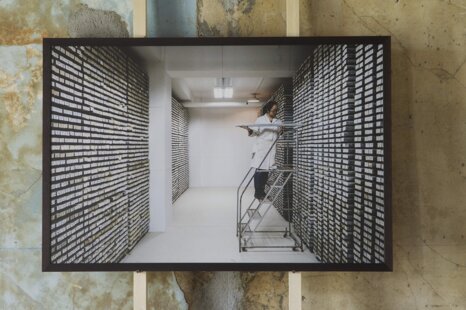postmaster@museumofanthropocenetechnology.org, via Leggiuno 32
2014 Laveno Mombello
Italia
The surface of the World’s oceans and their history (!), reduced to an archive of their sediment cores. A modern oceanographer could study the oceans without ever sailing them. An example of how modern science was in a way separated from it's subject: nature (see also Cat. Nr. 47).
From Fabio Cian's 2017 diary:
"The Lamont Doherty Core Repository is the biggest repository of ocean sediment cores in the world. It is located in the Lamont-Doherty campus of the Columbia University, in Palisades, 30 miles north of New York City by the Hudson river and contains more of 20 thousand cores collected from any point of the ocean.
The campus used to be the weekend residence of Thomas W. Lamont, a Wall Street banker, who died in 1948. After his death, his widow, Florence Corliss Lamont who was an alumna of Columbia University, donated the estate to Columbia in memory of her husband.
The site turned from a grandiose estate to a collection of eccentric scientists, where the sediment core collection was kept in the former dining room of Lamont hall, analyzed underneath chandeliers, chemically treated and stored in the Lamont family’s kitchen dishware.
From the early 1950’s to the late 1980’s Lamont research ships collected at least a core a day. The longest core collected was from central Pacific, 28.2-meter long.
In 1931, Harold Urey was the first to confirm the existence of hydrogen isotopes and of oxygen-18, the isotope of the more common oxygen-16. Urey discovered that the ratio of oxygen-18 to oxygen-16 in foraminifera, single celled organisms that live in the ocean and make their shells out of calcium carbonate, is sensitive to temperature. Abundance of oxygen isotope can be used to calculate ocean temperature from sediments. In the 50s, Cesare Emiliani, a student of Urey, analyzing the abundance of oxygen isotopes in sediments, produced the first record of ocean temperature stretching back nearly 300,000 years.
After few years form starting the collection of sediment cores, the dining room of Lamont Hall was full and the garage of Jack Nafe, a scientist living in the Lamont ground, was used with the promise that it would have been just for a year. Nafe never got back his garage, which was the first core repository now called “Nafe House”. Soon also Nafa’s garage became too small and a new repository was built. Ewing had the foresight to realize that new geochemical proxies and techniques would be available in the future in order to better study the cores. " (Fabio Cian)
Fabio Cian was funded by the Rachal Carson Foundation to photograph the work of climate scientists around the world. His presentation of the results of this project can be seen through this link.

Cat. Nr. 12
ARCHIVE OF OCEAN SEDIMENT CORES
2017, Fabio Cian
100 x 64 cm: in print on paper
postmaster@museumofanthropocenetechnology.org, via Leggiuno 32
Laveno Mombello
21014
Italia